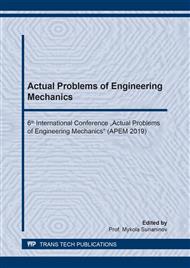p.161
p.168
p.176
p.185
p.200
p.209
p.227
p.234
p.240
Bearing Capacity of Structures Made of Materials with Different Tensile and Compression Strengths
Abstract:
The paper considers the problem of the ultimate load finding for structures made of a material with different limits of tensile strength and compression. The modulus of elasticity under tension and compression is the same. It is assumed that upon reaching the ultimate strength, the material is deformed indefinitely. The calculations use a simplified material deformation diagram — Prandtl diagrams. The limiting state of a solid rectangular section under the action of a longitudinal force and a bending moment is considered. The dependences describing the boundary of the strength of a rectangular cross section are obtained. Formulas allowing the calculation of the values of the limit forces and under the action of which the cross section passes into the plastic state are derived. Examples of the analytical calculation of the maximum load for the frame and two-hinged arch are given. An algorithm is proposed and a program for calculating arbitrary flat rod systems according to the limit state using the finite element method is compiled. The proposed algorithm does not involve the use of iterative processes, which leads to an exact calculation of the maximum load within the accepted assumptions.
Info:
Periodical:
Pages:
200-208
Citation:
Online since:
August 2019
Authors:
Price:
Сopyright:
© 2019 Trans Tech Publications Ltd. All Rights Reserved
Share:
Citation:


